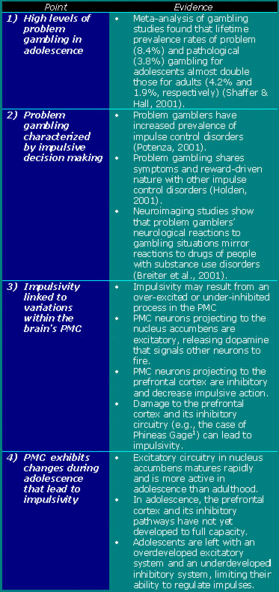The WAGER Vol. 8(40) – Biology, Addiction, and Gambling: What’s the Matter with Kids Today?
Several recent WAGER issues have focused on the role of impaired decision-making in problem gambling or other forms of addiction. For example, WAGER 8(34) described the neuroanatomical regions implicated in decision making processes and impairments. In this week’s WAGER, we review work by Chambers and Potenza (2003) that links the development of these neuroanatomical regions, impulsivity, and increased prevalence of gambling during adolescence.
Chambers and Potenza (2003) argue that problem gambling prevalence in adolescence can be explained by increases in impulsivity due to normal neurodevelopment at that age. Their argument is that:
- prevalence and incidence rates of problem gambling are higher in adolescence than in adulthood;
- problem gambling is characterized by impulse control problems leading to impaired decision making;
- impulsivity can be traced to variations in the brain’s primary motivation circuitry (PMC); (4) normal development of those systems during adolescence includes a period during which the typical adolescent brain looks and acts much like the motivationally impaired adult brain, resulting in impulsivity and vulnerability to problem gambling. These four points and the evidence to support them are displayed in
Table 1. Relationship between Problem Gambling, Impulsivity, and Neurodevelopment in Adolescence
The PMC areas essentially tell the brain which impulses to follow and when. If the PMC is unable to represent the pros and cons of acting on a given impulse or properly associate that action with its consequences, an impulsive decision or action can result. The PMC basically consists of loops of neurons, serving both excitatory (i.e., telling other neurons to fire) and inhibitory (i.e. telling other neurons not to fire) functions, projecting from the prefrontal cortex to the nucleus accumbens, to the thalamus, and back to the prefrontal cortex. Given what we know about adolescent behavior – teenagers’ impulsive decisions, novelty-seeking, and amazing knack for ignoring negative consequences – and what we know about neurodevelopment and hormonal activity at that time, Chambers and Potenza draw a connection between impulsive adolescent behaviors and the imbalanced development of excitatory and inhibitory circuitry in the PMC.
We note two limitations to Chambers and Potenza’s argument. First, recent research has called into question the high prevalence rates of problem gambling in adolescents. Hardoon, Derevensky, and Gupta (2003) found that adolescents’ own estimations of problem and pathological gambling (as compared to conclusions drawn from screens) produced prevalence rates identical to those of adults, calling into question rates drawn from screens. Since Chambers and Potenza’s argument depends on an increase in problem gambling during adolescence, more research is needed to understand the effect of measurement differences on these prevalence rates and map the change in rates from early to late adolescence. Secondly, although their argument is empirically based and logically sound, it is still speculative. We read that problem gambling increases during adolescence, that adolescence is a time of increased impulsivity, that problem gambling involves impulsive decision making, and that brain systems involved in impulse control are under development during adolescence, and are encouraged to connect the dots, but we do not have direct evidence of causal links between these findings. Perhaps this is less a limitation and more a call for future research.
The argument constructed by Chambers and Potenza makes a compelling case for both the role of neurobiology in problem gambling and also the common etiology of behavioral addictions, drug addictions, and other impulse control disorders (see Chambers, Taylor, & Potenza, 2003, also). Importantly, the article points not only to impairments in the adult brain but also to normal neurodevelopment in adolescence as vulnerabilities for impulse control disorders, particularly gambling and substance use disorders. What’s the matter with kids today? They’re growing up.
Comments on this article can be addressed to Sarah Nelson.
Notes
1 Phineas Gage survived an accident that sent an iron tamping rod through his frontal lobe. As a result of the injury to this area of his brain, he became impulsive, emotional, and incapable of making sound decisions or executing plans (Damasio et al., 1994).
References
Breiter, H. C., Aharon, I., Kahneman, D., Dale, A., & Shizgal, P. (2001). Functional imaging of neural
responses to expectancy and experience of monetary gains and losses. Neuron, 30(2), 619-639.
Chambers, R. A., & Potenza, M. N. (2003). Neurodevelopment, impulsivity, and adolescent gambling. Journal of Gambling Studies, 19(1), 53-84.
Chambers, R. A., Taylor, J. R., & Potenza, M. N. (2003). Developmental neurocircuitry of motivation in adolescence: A critical period of addiction vulnerability. American Journal of Psychiatry, 160(6), 1041-1052.
Damasio, H., Grabowski, T., Frank, R., Galaburda, A. M., & Damasio, A. R. (1994). The return of Phineas Gage: Clues about the brain from the skull of a famous patient. Science, 264, 1102-1105.
Hardoon, K., Derevensky, J. L., & Gupta, R. (2003). Empirical measures vs. perceived gambling severity among youth: Why adolescent problem gamblers fail to seek treatment. Addictive Behaviors, 28, 933–946.
Holden, C. (2001). Behavioral addictions: Do they exist? Science, 294, 980-982.
Potenza, M. N. (2001). The neurobiology of pathological gambling. Seminars in Clinical Neuropsychiatry, 6, 217-226.
Shaffer, H. J., & Hall, M. N. (2001). Updating and refining prevalence estimates of disordered gambling behaviour in the United States and Canada. Canadian Journal of Public Health, 92(3), 168-172.
